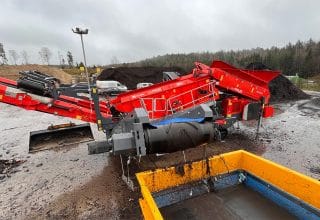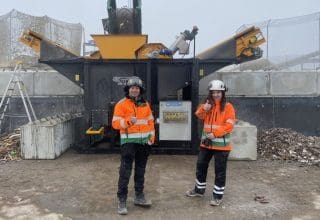Recycling of waste sand with Skanska and Gävle municipality
This project is a good example of how a simple recycling solution creates good economics while reducing emissions and the use of virgin material extraction. The recycling of ice dams also contributes to a safer everyday life during the winter months.
Recycling of grit and anti-skid with water bath
Traditionally, newly created sand has been used to combat skidding, leading to significant environmental impacts. This sand, blasted from bedrock, has often been disposed of after use due to contamination - a practice that is neither sustainable nor cost-effective.
Norditek, in collaboration with Skanska, has transformed this process by introducing a circular approach. By reusing the litter, we have created a method that not only saves resources but also reduces the environmental impact. As a result of this work, we are now able to clean and reuse a large part of the swept-up litter, which was previously unthinkable.
The process from collection to reuse
Steps 1: Sorting and preparation
After the sand is collected, the process begins with a thorough sorting. Here, all non-rock material such as sticks, leaves and other debris are separated. This first phase is crucial to ensure the purity and quality of the recycled material.
Step 2: Purification in water bath
The second step involves placing the sand in a water bath. Here organic material, which should not be there, floats to the surface and is filtered out. This step ensures that only the usable rock material remains.
Step 3: Filtration of stone material
In this step, too large and too small stones are filtered out, ensuring that the grain size of the sand is optimal for slip control. This precision is crucial to the sand's effectiveness and safety profile. Read more about Our filtration technology here.
Step 4: Washing and quality control
The sand is thoroughly washed and undergoes continuous quality controls to ensure that it is clean and meets all safety and environmental standards. This phase is critical to preserve the functional properties of the sand.
Step 5: Mixing and reuse
If necessary, the recycled material is mixed with new sand to achieve the desired efficiency. This final phase of the process allows for reuse of the material, reducing the need for new material and contributing to a reduced environmental impact.
Circularity and environmental benefits
Through this project, we are reducing the need for new sand, reducing landfill and shortening transportation distances, which are crucial steps towards a greener and more sustainable future.
In our quest to promote sustainable development, this project is a shining example of how we can make a difference. By combining innovation with environmental awareness, we are creating solutions that not only benefit us today but also ensure a better world for future generations.

Technical specification
Input: Waste sand from an urban environment that has been lying for a long time, wet and with a lot of organic matter that has decomposed into soil.
Output: fine fraction 0/2 mm (as noise barrier or roundabout soil) depending on the degree of purity.
Intermediate fraction: 2/8 mm slipping block that needs to go in the water bath to wash away the last fine material and separate out liquid organics.
Overfraction: +8 mm, stones, sticks, "debris". Can be wind sifted to obtain a stone fraction.
Want to know more
about this project?




